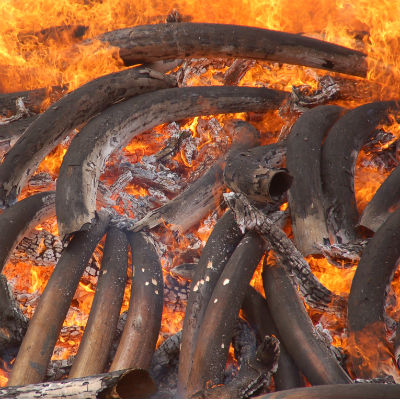Burning ambition
BURNING AMBITION
What is it like to attend an ivory burn? As part of our Elephants in Crisis campaign, Born Free’s President and Co-Founder, Will Travers OBE, describes the tumult of emotions he felt at two ivory burns in Kenya
There is a lot of controversy surrounding the burning or destruction of ivory. I am 100% behind removing all ivory from commercial use. Destroy it; lock it up in a museum as a reminder to future generations; register it and use it for educational purposes; keep it on the top shelf at home next to the ceremonial knife that great uncle Albert brought back as a memento nearly 100 years ago – but do not sell it.
I have been to two great ivory burns, both in Kenya and over 25 years apart.
You might imagine that my abiding memory – the image burned into my mind – was of great crescent tusks, part-shrouded in smoke, licked by relentlessly curious red and yellow flames. You might think my senses reeled from the smell of death being consumed by fire – acrid, billowing, cling-to-your-clothes, inescapable. You might think that the noise, the crick-crack of tusks splitting under the intense heat, supercharged by a mixture of wood, glue and kerosene (ivory burns at an unusually high heat), would be my lasting impression.
No.
My abiding memories of these two great conflagrations are my feelings of sun and joy, and rain and remorse.
In 1989, maybe 500 people, including several hundred members of the world’s press and media, gathered in an open space on the edge of Nairobi National Park to watch President Daniel Arap Moi, flanked by Dr Richard Leakey, sink a burning torch into a 12 tonne pyre. Conservationists and curious members of the public watched to see what would happen – it had never been done before on such a scale. Saba and Dudu Douglas-Hamilton, the daughters of Dr Iain Douglas- Hamilton whose work had done so much to alert the world to the killing fields of Africa and the impact of the bloody ivory trade, whooped and danced with joy. The sun shone, the crowd cheered, the mood was one of unrelenting hope.
At last a smoke signal had been sent to the international community. Enough is enough. The slaughter which had seen Africa’s elephant population halve in just 10 years had to be stopped!
Maybe a thin curl of smoke, caught on the savannah breeze, found its way across the Sahara and the Mediterranean and into the grey, businesslike meeting halls of the Lausanne convention centre in Switzerland. Maybe the wildlife trade delegates, gathering there just a few months later, paused in their deliberations, trying to identify the strange scent that caused them inexplicably to think of Africa. Whatever it was, in September 1989, the world voted to ban the international trade in ivory. We thought elephants were safe.
So why, in almost the same location, on the fringe of Nairobi National Park some 27 years later, was I standing as silent witness to another ivory burn? Not 12 tonnes this time, but 110 tonnes, the last mortal remains of perhaps 8,000 wild, beautiful, magnificent African elephants. Not just more ivory, but more people. About 1,000 or more came to pay their respects and to watch another Kenyan President, Uhuru Kenyatta, send another smoke signal. No sun this time, just relentless tears from heaven, soaking us to the skin, mourning the departed.
It seemed fitting that as, one after another, huge stacks of rain-soaked ivory were reduced to ashes. There was no cheering. Stern security officers from the Kenya Wildlife Service watched to ensure no ivory went ‘missing’. Fire brigade crews attended to persistent flames that threatened to get out of control. Dignitaries, somewhat bedraggled in the downpour, uttered suitable speeches and made the kind of outrageous promises of action and hope that only politicians can make.
But all I could think about were the elephants. Thousands of dead elephants, tens of thousands of their grieving relatives, and the utter human greed and disregard for our responsibilities as compassionate custodians of the natural world that had led to this unnatural catastrophe.
Africa’s elephant population has halved again, down to a precarious 400,000 or so. The illegal ivory trade is rampant, aided and abetted by stupid decisions made by stupid people who believe that demand for ivory can be controlled – and that elephants can be ‘harvested’ like corn.
So, the fight is on once more. Africa’s great grey ghosts are in the firing line. The traders in death and destruction again hold sway over some of Earth’s most precious wild places, and ill-equipped and underpaid rangers are wounded, maimed and die with alarming regularity, laying down their lives to protect elephants on our behalf.
In 1989, elephants were in crisis. Make no mistake, they are in crisis today. I never thought I would see history repeat itself, but I was naive. We seem incapable of learning from past mistakes. We seem bent on revisiting them.
Einstein famously said that the definition of madness is repeating the same experiment time and time again and expecting a different result. In that case, many of those in charge of our natural world are certifiable.
If they won’t fix it, then we must. That is my mission. Join me.

